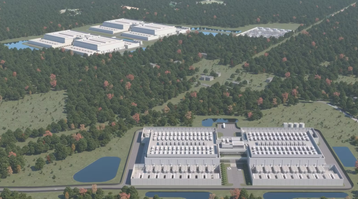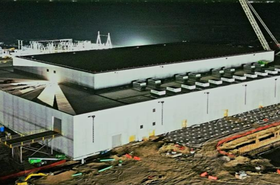Jim Trout’s CV could easily pass for a directory of the data center industry’s biggest names.
From CoreSite to Vantage via Digital Realty, the CleanArc Data Centers CEO has been at the forefront of digital infrastructure development for 25 years, and after a spell working as an investor, is now back in the game with CleanArc, which is developing hyperscale facilities, initially in Virginia.
His enthusiasm seems undimmed when he catches up with DCD in the wake of CleanArc taking funding from Nuveen, the investment manager for the TIAA pension fund. The size of the investment has not been made public, but given that Nuveen has $1.3 trillion of assets under management, it’s likely Trout and CleanArc have a fair bit of cash burning a hole in their corporate back pocket.
But, having left Vantage in 2013, did he ever think he’d find himself building another data center company? “I was working on water conservation technologies, making angel investments, and buying up real estate for my own portfolio,” he says. “But in 2018, I was looking at the market and thinking ‘this is just too crazy.’
“We’re at the next stage of a quantum leap of adoption, a doubling or tripling of capacity needs. I’ve always loved opportunities where you can align with your customers, and you can collaborate and have a planning process with them. That’s what we’re doing with some of the biggest hyperscalers.”
Trout makes a splash
Trout started his commercial real estate career with Prologis, before taking a role with investment fund Carlyle Group, helping it “to develop a business plan for its West Coast assets.”
These assets would become CoreSite, the data center and telecoms infrastructure firm Trout helped found in 2001, serving as CEO for two years when it was known as CRG West and operating out of one of the original carrier hotels, One Wilshire in Los Angeles. “It was very network-centric, and difficult to scale in certain areas,” he recalls. “I said to them, ‘this is going to be a great business, but we need to get into a larger data center experience to be able to grow with corporate America.”
Having set CoreSite on the path to growth, in 2003 he moved over to the fledgling Digital Realty to “run the operations” of a company that would go on to be one of the largest investors and builders for digital infrastructure. “I had portfolio management and technical operations, and grew that team from eight to 500,” he says. “We went public and expanded from there, but the problem with the model at the time was that there was limited modularization, so it was difficult to scale it to true hyperscale.”
Trout’s desire to build big was matched by another private equity firm, Silverlake, which came calling in 2009, asking him to launch a new business, Vantage Data Centers, initially in Silicon Valley, where it acquired a former Intel data center. “There was an opportunity with this Intel campus redevelopment that I saw and thought ‘wow, we can really get high voltage power close to deployment’,” he says.
With what was, for the time, a massive 37MW of power available at the site, it’s no surprise Trout’s eyes lit up at the prospect. Vantage launched its data center in Santa Clara in 2011, the first of what would go on to be a network of large wholesale colo sites around the world. “We got Vantage to a point where it was monetizable into DigitalBridge’s portfolio [DigitalBridge acquired the company in 2017], I’m super proud of what we achieved,” Trout says.
Clean growth
Now his focus is on CleanArc, the company launched in 2023 by power investor 547 Energy. It has since taken PE funding from Snowhawk, which became the firm’s biggest shareholder in the process, as well as Townsend Group and, most recently, Nuveen.
All this capital will be used to fund the build-out of hyperscale data centers fit for the AI age. CleanArc says it will deliver these data centers to its clients with renewable energy matching agreements already in place, ensuring they fit with the hyperscalers’ net-zero ambitions. The company launched an RFP for clean power partners in 2023, receiving expressions of interest from projects totalling 3GW.
How many of these will come to fruition and over what time period remains to be seen, but it has secured sufficient power to deliver its first campus, in Virginia’s Caroline County. This will eventually offer 600MW at full build-out, with 200MW due to be online by Q2 2026, and a further 300MW following by mid-2027.
Since our interview, the Caroline County site has been given the green light by local officials, and CleanArc has purchased an additional 87.5 acres of land, which will enable it to deliver another 300MW at the campus.
Who will be moving in has yet to be announced, but Trout says the company is working with two hyperscale clients interested in doing deals for CleanArc infrastructure.
“We have bi-weekly calls and we’re helping them through the whole supply chain process,” he says. “We’re integrating as much as we can in terms of power, land, and then some level of infrastructure, and letting them decide. Every company’s supply chain management is different, so we’re being flexible and adjusting while we do these initial deals.”
Though not naming the hyperscalers involved, he says CleanArc has carried out technical due diligence – a process that puts the company and its capabilities under the microscope – with both. “Now we need to show them we have the ability to respond to different CPU and GPU designations, not only those that are on the market now but also Nvidia’s future designs,” he says. “We need to show technological flexibility.”
It will be up to the clients themselves to decide what mix of renewable energy offsets the emissions from their servers, Trout adds. “My view is we source a lot of solar and wind, then add batteries as an option and nuclear as an option – it’s up to the hyperscalers whether they consider [nuclear] renewable from their perspective,” he says.
A changing landscape
Beyond Virginia, Trout says CleanArc is looking to other US markets and different products.
“We are working on multiple other sites in other Tier One markets,” he says. “We have several under contract, but there’s a process to get the power fully fleshed out. What’s exciting is that, after the recent investments, we’ve been able to get into a more aggressive mode.”
CleanArc is also investigating other types of data centers, catering to enterprise users, something Trout did to good effect at Vantage, bagging deals with the likes of Boeing.
“We’re looking at things that would be more Edge and corporate AI-driven,” he says. “We’re in active discussions with Fortune 100 companies about what that could look like. They don’t have the size of the hyperscalers, but we’re still talking about 25-50MW facilities, which are big enough for us to work with and can help us diversify.”
The data center industry has changed immeasurably since Trout took his first steps with CoreSite, but he says the things that drive him are unchanged. “The excitement of the job for me has always been building small teams of young people and building capability at a platform level,” he says. “I really like going in from the ground level, and being the founder of an idea and a strategy that has legs and is scalable.”
But he admits he didn’t anticipate the magnitude of the sector’s growth back when he was starting out in the early 2000s.
“I didn’t see it getting this big, this fast,” he says. “But it’s still a really challenging environment with long sales cycles, and with very sophisticated clients that aren’t afraid to throw their weight around. But now I can show the quality of my team, and my investors, and that puts us on more of an equal footing.”
This feature first appeared in DCD>Magazine #58. Register here to read the whole magazine free of charge.
Read the orginal article: https://www.datacenterdynamics.com/en/analysis/jim-trout-cleanarc-data-centers-ceo-digital-realty-coresite-vantage/











